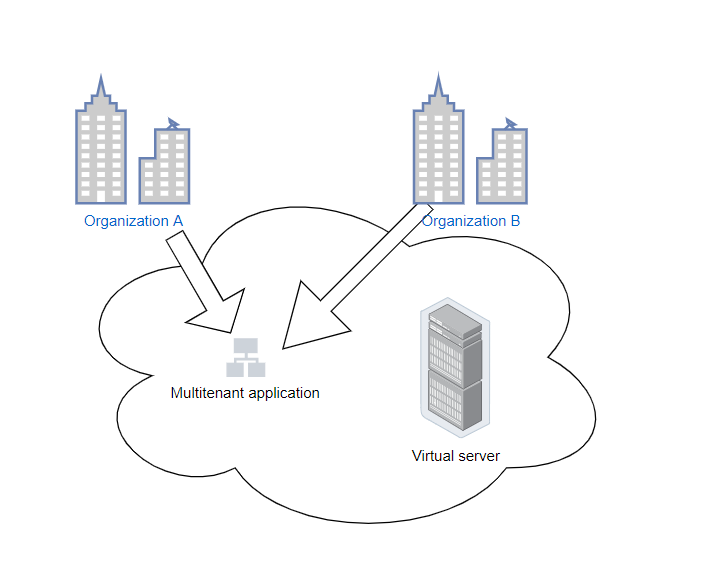Hi my fellow technology lovers, I wanted to talk about a subject that is barely acknowledged in its true form. The subject is “Cloud Computing” and will be discussed in sequence. So, let ‘s delve into the cloud computing universe. In this blog I am going to talk about “Multi -tenancy in cloud computing”.
What is Multi-Tenancy?

To allow multiple users (tenants) to concurrently access the same application logic, the multitenant application architecture was developed. As a dedicated instance of the programme, each tenant has its own view of the application that it uses, administers, and customises while being unaware of other tenants using the same application.
While all software users access the same basic elements, the customer-specific data and settings are housed in a different and protected bin. Users will use any of the software’s features, but their data would not be exchanged.
Multitenancy is cloud computing ‘s backbone architecture and this is where it is mostly used. It operates as many concurrently related users access the same programme over the Internet. Such software is usually stored, provisioned, and operated by a cloud provider. Each customer, or occupant, may personalise the preferences and configurations of the app. Both configurations, however, are supplied within the same instance of programme without having access to the source code. Click here for cloud based solutions for the businesses like Google, AWS and Azure.
Multitenancy is a software model where several, distinct user classes may be served by a single software example. An instance of multitenant architecture is software-as-a-service (SaaS) offerings.
Multitenancy may also refer to shared hosting in cloud computing, in which server services are distributed among numerous customers.
Benefits of Multi-tenant
Lower cost: Since the multi-tenant architecture requires facilities, accounts, resources, and software to be shared, it can cost less than a single-tenant arrangement. Scaling has less effects when the same programme can be used by new customers as the original owners.
Expedient Maintenance, and Upgrades: In the case of SaaS Multi-Tenant Architecture, to keep the programme up to date, consumers do not have to pay substantial fees. In general, maintenance expenses are aligned with a SaaS subscription and are not paid as in a Single-Tenant arrangement per case. As they use the code from the same pool, the maintenance costs, especially for improvements, are shared by all tenants. This cuts the total operating expense for each tenant. Click here for general IT Support services for Businesses
Lower computing capacity: The multi-tenant architecture provides organizations with the ability to stay in the same data centre and infrastructure. Therefore, customers will not have to think about adding more server or computing capacity.
Drawbacks of Multi-tenancy
Downtime: Multi-tenant SaaS relies on complicated and broad databases that frequently require downtime for software and hardware. This poses difficulties with consumer availability and can make the organisation look less reliable.
Customization: Multi-tenancy has less customizations and consumers do not have complete control over the consistency of the environment when infrastructure and facilities are shared by many clients. With less power, customising the app to the unique needs of the organisation is challenging.
Security: Your details will not be used by any tenants. However, on the same database, multiple users (not affiliated with your organisation) are allowed. This larger access lowers security control. Click here for cyber security related issues of businesses
Single-Tenant SaaS
Single-tenant SaaS is an architecture in which the tenant is the SaaS client. Each team has a dedicated server and supporting facilities in the Single-Tenant SaaS community. It is not possible to share single-tenant items between users and the customer can configure the app according to their specifications. For an individual example of software, the customer may configure the interface to suit their organisation or team’s specifications.
Benefits of single tenant
Security: With single tenancy, the data of each client is completely segregated from other clients. Therefore, one consumer cannot access the confidential details of another. This structure, exploiting encryption, defends against hacking.
Dependability: For a whole ecosystem devoted to one consumer, services are often abundant and usable.
Restore and backup: Since the database of each customer has an isolated copy, it becomes simpler in a single-tenant SaaS system to rebuild or copy the database. Your team can quickly view past details and recover previous configurations since the device is backed up to a dedicated portion of the SaaS server. Your records will all be kept in a space unique to your account.
Individual updates: Companies using the architecture of single tenancy will independently update their services. Rather than waiting for a universal upgrade to be released by the software vendor, users can update their accounts as soon as the application is available. And, if they need to update their applications, this does not interrupt their workflow. During off-hours, they will opt to initiate updates instead of being required to update at the same time as anyone else.
Drawbacks of single tenant
Cost: One of the main downsides of the single-tenant SaaS architecture is the higher cost, as it does not allow cost-sharing for resources such as deployment and monitoring. Every new client wants a new instance, and it is important to pay for each of those instances.
Maintenance: To keep things going smoothly and effectively, single tenant usually means more duties and occasional maintenance.
Setup / Management: SaaS multi-tenant environments are easy to setup and maintain by contrast. Click here to purchase any IT related software or hardware
Conclusion
After evaluating the advantages and disadvantages of the design of single-tenant SaaS and multi-tenant SaaS it is concluded that multi-tenancy provides more long-term investment and growth opportunities for SaaS technology vendors. While it is not an easy task as it poses immense privacy and security problems, it provides the company with greater data capability and a higher ceiling.
